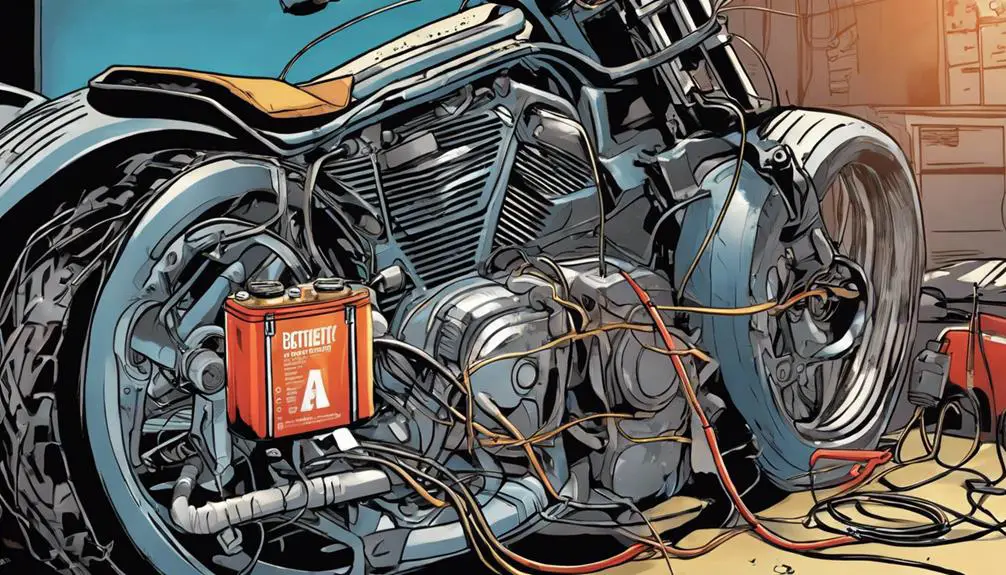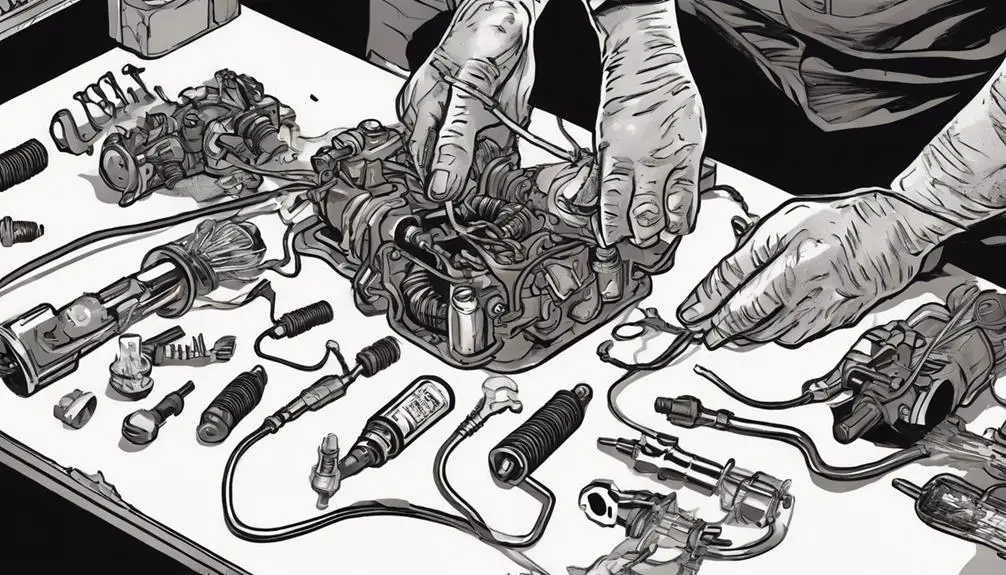When you're out on the road, electrical issues in your motorcycle can really ruin your ride. You might find yourself facing dead batteries, faulty ignition systems, or degraded wiring—each with its own set of frustrating symptoms. These problems often sneak up on you, turning a simple trip into a headache. Understanding these common issues can help you prevent unexpected breakdowns, but knowing how to address them is vital. So, what steps can you take to guarantee your bike stays in top shape?
Key Takeaways
- Dead Battery: A dead battery is a frequent issue, often due to age or poor connections, impacting overall motorcycle performance.
- Faulty Ignition System: Problems with the ignition coil or spark plugs can prevent engine starting and require thorough inspection and replacement.
- Wiring Issues: Degraded or damaged wiring can cause intermittent failures, leading to malfunctioning lights and gauges.
- Corroded Electrical Connections: Loose or corroded terminals disrupt power flow, making regular maintenance checks essential for reliability.
Battery and Charging Problems

When it comes to battery and charging problems, you're likely to encounter issues like a dead battery or a faulty charging system that can leave you stranded. You depend on your motorcycle for freedom, and these setbacks can feel like chains holding you back.
First, check your battery. A simple voltage test can reveal whether it's holding a charge or on its last legs. If it's dead, you might just need a jump-start, but don't ignore the age of the battery; most last about three to five years.
Next, examine your charging system. If your bike runs but the battery drains quickly, the regulator/rectifier might be malfunctioning. This essential component manages the voltage flow, ensuring your battery gets charged properly.
Keep an eye on your motorcycle's electrical connections too. Loose or corroded terminals can disrupt the power flow. Regular maintenance checks can help you catch these issues early, giving you the confidence to ride freely.
Don't let battery and charging problems clip your wings; stay vigilant and prepared, and you'll enjoy the open road without fear of being grounded.
Wiring and Connector Issues
Battery and charging problems often lead to wiring and connector issues that can compromise your motorcycle's performance. When these connections degrade, they can cause intermittent electrical failures, leaving you stranded and frustrated.
It's crucial to regularly inspect your wiring for signs of wear or damage, such as fraying or corrosion. You should pay special attention to connectors, as loose or dirty connections can lead to erratic behaviors like flickering lights or malfunctioning gauges.
Cleaning connectors with electrical contact cleaner can restore some functionality, but if they're damaged, replacement is your best option.
Additionally, look for any areas where wires might rub against metal surfaces; this can create shorts or breaks. Using protective sleeves or tape can help shield these vulnerable spots.
Ignition System Failures

Ignition system failures can prevent your motorcycle from starting, leaving you frustrated and stuck. When you turn the key, you expect that powerful roar of the engine, but instead, you might hear nothing. This often stems from issues like a faulty ignition coil, spark plugs, or even a dead battery. If your bike's not igniting, you'll want to check these components first.
Start with the battery; a weak or dead battery can kill your ride. Make sure connections are clean and tight.
Next, inspect the spark plugs. Worn or fouled plugs can cause weak sparks or none at all. Replace them if they look worn down.
Don't forget the ignition coil! If it's malfunctioning, it can disrupt the electrical flow necessary for ignition. Testing with a multimeter can help you diagnose the issue.
Frequently Asked Questions
How Can I Tell if My Motorcycle's Electrical System Is Overloaded?
To tell if your motorcycle's electrical system is overloaded, watch for dim lights or flickering indicators.
If your battery struggles to start the engine or drains quickly, that's a sign too.
You might notice unusual smells or hear strange noises from the electrical components.
Keep an eye on your fuses; if they blow frequently, it's time to investigate.
Trust your instincts and take action before it leads to bigger issues.
What Tools Do I Need for Basic Electrical Troubleshooting?
Picture yourself under the open sky, tools in hand, ready to tackle electrical mysteries.
You'll need a multimeter to measure voltage and resistance, wire strippers to trim away the old, and a soldering iron for secure connections.
A good flashlight illuminates dark corners, while electrical tape keeps everything tidy.
With these tools, you're not just fixing problems; you're liberating your ride, ensuring it roars to life with every twist of the throttle.
Can Weather Conditions Affect Motorcycle Electrical Systems?
Absolutely, weather conditions can affect your motorcycle's electrical systems.
Rain and humidity can cause corrosion on connections, leading to shorts or failures.
Extreme heat can damage components, while cold can affect battery performance.
You should regularly check your wiring and connectors, especially after riding in harsh conditions.
Keeping your motorcycle clean and dry can help protect it from weather-related issues, ensuring you enjoy the freedom of the open road without interruptions.
How Often Should I Inspect My Motorcycle's Electrical Components?
You should inspect your motorcycle's electrical components regularly, ideally every few months.
It's a good practice to check them before long rides or after harsh weather conditions.
Look for any signs of wear, corrosion, or loose connections.
Keeping up with these inspections not only guarantees your bike runs smoothly but also gives you the freedom to ride without worry.
Embrace the journey and make certain your ride's electrical system is in top shape!
What Are the Signs of a Failing Voltage Regulator?
What if your ride's power source starts to falter? If you notice flickering lights, a dead battery, or erratic voltage readings, your voltage regulator might be failing.
You might also experience stalling or difficulty starting your motorcycle. Pay attention to unusual noises or smells, too; they could signal trouble.
Don't wait for a breakdown—check your electrical system regularly to keep your freedom on two wheels intact and your adventures alive!
Conclusion
In the world of motorcycles, electrical issues can be like storm clouds on a sunny ride.
By keeping an eye on your battery, ensuring your wiring's in top shape, and staying ahead of ignition problems, you can steer clear of these pitfalls.
Regular maintenance is your best shield against electrical woes, allowing you to enjoy the open road with confidence.
So, rev up your bike and keep those electrical gremlins at bay for a smoother journey ahead!